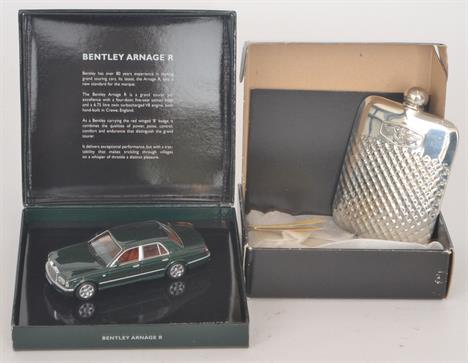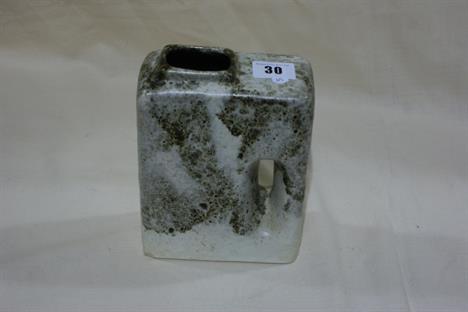We found 52449 price guide item(s) matching your search
There are 52449 lots that match your search criteria. Subscribe now to get instant access to the full price guide service.
Click here to subscribe- List
- Grid
-
52449 item(s)/page
A GOOD LARGE 19TH/20TH CENTURY CHINESE CLOISONNE DOUBLE MOON FLASK, the sides decorated with turquoise-ground scenes of dragons, phoenix, buddhistic lions and kylin within formal key-fret borders, the base with an engraved four-character Qianlong mark, together with a fitted box, the flask 15.5in high & 15.4in wide.
Hunting Memorabilia, including three sets of antlers, one on an oak shield dated 1930, two pairs of black leather boots, one with beech trees, top hat in box, sandwich box and flask in a stitched leather case, brass hunting horn by Swaine & Adeney, in a stitched leather case, two whips, two shooting sticks, tea set, etc
An amber glazed stoneware pilgrim flask, Liao dynasty, modelled after a leather prototype, the swelling body flattened at the top with a finger pinched loop handle, attached to a cylindrical spout, covered with thin-bright green glaze over a white slip falling irregularly to reveal the buff coloured body, 23cm high. Vessels bearing similar shape to the present one were also known as “cockscomb pots”, jiguanhu, or horse-stirrup pots, madenghu. These bottles appear to have originated from the Mongolian leather satchel-like containers employed by early Qidan people from as early as the 4th century AD, to store liquids such as water, milk and wine. Such vessels have been mainly excavated from graves belonging to members of the Qidan aristocracy. The simulated holes for attachment of a carrying strap and the raised stitched-like decoration and rivets are typical features occurring on the earliest ceramic versions of this form. Indeed, later forms, bearing loop handles, would seem to suggest the adoption of a sedentary life on behalf of the Qidan, following their contacts with their Han Chinese neighbours. Comparable examples of cockscomb bottles have been unearthed from Liao dynasty tombs in Liaoning and Inner Mongolia and can also be found in notable private collections, mainly located in Hong Kong, such as the Mengdiexuan, Xiwenguo Zhai and Jiurutang.Bid Live at the-saleroom.com
A Chinese blue and white dish decorated with two dragons contending a flaming pearl, 28.5cm diameter, 18th century, a blue and white tankard decorated with a continuous riverside scene, 12cm high, a blue and white moon flask decorated with two panels featuring garden scenes amid a profusion of flowers, with chilong shaped handles, 31cm highBid Live at the-saleroom.com
A George V silver plated metal mounted ebonised wood system walking stick, circa 1920, the handle relief cast with flowers and foliage, lifting off to reveal a measuring stick within the tapered shaft, with metal ferrule, 88.5cm high; a brass mounted stained hardwood system walking stick, second half 20th century, the foliate cast handle unscrewing to a stoppered glass flask within, 88.5cm high; an antler mounted bamboo system walking stick, probably previously a gun stick, circa 1900, a wood stopper above the handle opening to a steel barrel within, the ferrule with a sighting bead, 89cm high; and a faux ivory mounted bamboo sword stick, 20th century, the grip modelled as a monkey’s head with cap, 92cm highBid Live at the-saleroom.com
Three brass mounted stained hardwood system walking sticks, second half 20th century, one with grip cast as a duck’s head, unscrewing to a cavity within, the shaft also unscrewing in two places for packing, 88cm high; another example with similar shaft construction, topped with a foliate cast handle, a glass nip flask within, 89.5cm high; the third with spherical grip unscrewing to a small cavity within, 88.5cm highBid Live at the-saleroom.com
A brass mounted stained wood system walking stick, second half 20th century, the handle cast as the stylised head of a bird of prey, unscrewing to a small cavity within, the shaft unscrewing at two points, 91.5cm high; a brass mounted stained hardwood system walking stick, second half 20th century, the foliate cast grip unscrewing to a glass flask within, 88.5cm high; and a brass mounted ebonised wood system walking stick, mid 20th century, the grip fitted with a quartz timepiece, 86.5cm highBid Live at the-saleroom.com
A stained beech and brass mounted photographer’s system walking stick, circa 1915, the bun grip with cylindrical collar and the brass ferrule detaching to free the three section shaft, opening as a tripod, the hinged fitting at the top with a projecting bolt to take a camera, each leg with a telescopic aluminium rod within for greater height, 95cm high closed as a stick; and a copper mounted snakewood system walking stick, second quarter 20th century, the cap unscrewing to a nip glass within, the shaft unscrewing to a glass flask, 90.5cm highBid Live at the-saleroom.com
A Victorian malacca sword stick, late 19th century, the steel blade inscribed ‘LONDON’, the shaft with metal ferrule, 90cm high; a leather and aluminium mounted hardwood shooting stick, second quarter 19th century, with hinged seat rests and a screw off disc to fit above the pointed ferrule, 86cm high; an early George V silver mounted ebonised wood cane, the grip hallmarked for London 1910, 92.5cm high; a metal mounted bamboo swagger stick, early 20th century, the grip with a coat of arms and motto for the ‘ROYAL ARMY MEDICAL CORPS’, 70.5cm long; a brass mounted stained hardwood system walking stick, second half 20th century, the bulbous grip unscrewing to two metal nip cups above a cavity for a flask (now missing), 92cm high; and an Oriental enamelled walking stick handle, 12.5cm highBid Live at the-saleroom.com
An amber glazed stoneware pilgrim flask, Liao dynasty, modelled after a leather prototype, the swelling body flattened at the top with a finger pinched loop handle, attached to a cylindrical spout, covered with thin-bright green glaze over a white slip falling irregularly to reveal the buff coloured body, 23cm high. Vessels bearing similar shape to the present one were also known as cockscomb pots, jiguanhu, or horse-stirrup pots, madenghu. These bottles appear to have originated from the Mongolian leather satchel-like containers employed by early Qidan people from as early as the 4th century AD, to store liquids such as water, milk and wine. Such vessels have been mainly excavated from graves belonging to members of the Qidan aristocracy. The simulated holes for attachment of a carrying strap and the raised stitched-like decoration and rivets are typical features occurring on the earliest ceramic versions of this form. Indeed, later forms, bearing loop handles, would seem to suggest the adoption of a sedentary life on behalf of the Qidan, following their contacts with their Han Chinese neighbours. Comparable examples of cockscomb bottles have been unearthed from Liao dynasty tombs in Liaoning and Inner Mongolia and can also be found in notable private collections, mainly located in Hong Kong, such as the Mengdiexuan, Xiwenguo Zhai and Jiurutang.
A Chinese blue and white dish decorated with two dragons contending a flaming pearl, 28.5cm diameter, 18th century, a blue and white tankard decorated with a continuous riverside scene, 12cm high, a blue and white moon flask decorated with two panels featuring garden scenes amid a profusion of flowers, with chilong shaped handles, 31cm high
A George V silver plated metal mounted ebonised wood system walking stick, circa 1920, the handle relief cast with flowers and foliage, lifting off to reveal a measuring stick within the tapered shaft, with metal ferrule, 88.5cm high; a brass mounted stained hardwood system walking stick, second half 20th century, the foliate cast handle unscrewing to a stoppered glass flask within, 88.5cm high; an antler mounted bamboo system walking stick, probably previously a gun stick, circa 1900, a wood stopper above the handle opening to a steel barrel within, the ferrule with a sighting bead, 89cm high; and a faux ivory mounted bamboo sword stick, 20th century, the grip modelled as a monkey?s head with cap, 92cm high Please note, the fourth stick described has been withdrawn from this lot.
Three brass mounted stained hardwood system walking sticks, second half 20th century, one with grip cast as a ducks head, unscrewing to a cavity within, the shaft also unscrewing in two places for packing, 88cm high; another example with similar shaft construction, topped with a foliate cast handle, a glass nip flask within, 89.5cm high; the third with spherical grip unscrewing to a small cavity within, 88.5cm high
A brass mounted stained wood system walking stick, second half 20th century, the handle cast as the stylised head of a bird of prey, unscrewing to a small cavity within, the shaft unscrewing at two points, 91.5cm high; a brass mounted stained hardwood system walking stick, second half 20th century, the foliate cast grip unscrewing to a glass flask within, 88.5cm high; and a brass mounted ebonised wood system walking stick, mid 20th century, the grip fitted with a quartz timepiece, 86.5cm high
A stained beech and brass mounted photographers system walking stick, circa 1915, the bun grip with cylindrical collar and the brass ferrule detaching to free the three section shaft, opening as a tripod, the hinged fitting at the top with a projecting bolt to take a camera, each leg with a telescopic aluminium rod within for greater height, 95cm high closed as a stick; and a copper mounted snakewood system walking stick, second quarter 20th century, the cap unscrewing to a nip glass within, the shaft unscrewing to a glass flask, 90.5cm high
A Victorian malacca sword stick, late 19th century, the steel blade inscribed LONDON, the shaft with metal ferrule, 90cm high; a leather and aluminium mounted hardwood shooting stick, second quarter 19th century, with hinged seat rests and a screw off disc to fit above the pointed ferrule, 86cm high; an early George V silver mounted ebonised wood cane, the grip hallmarked for London 1910, 92.5cm high; a metal mounted bamboo swagger stick, early 20th century, the grip with a coat of arms and motto for the ROYAL ARMY MEDICAL CORPS, 70.5cm long; a brass mounted stained hardwood system walking stick, second half 20th century, the bulbous grip unscrewing to two metal nip cups above a cavity for a flask (now missing), 92cm high; and an Oriental enamelled walking stick handle, 12.5cm high
**A CAUCASIAN SILVER-MOUNTED POWDER-FLASK, SECOND QUARTER OF THE 19TH CENTURY of carved burrwood, with tapering horn-shaped body, fitted with large nielloed silver mounts comprising nozzle, basal collar and a central band, the latter fitted with curved iron spring cut-off, inlaid with brass scrolls, set with pearls (one missing), and with two silver loops for suspension 20 cm; 8 in
-
52449 item(s)/page

























































